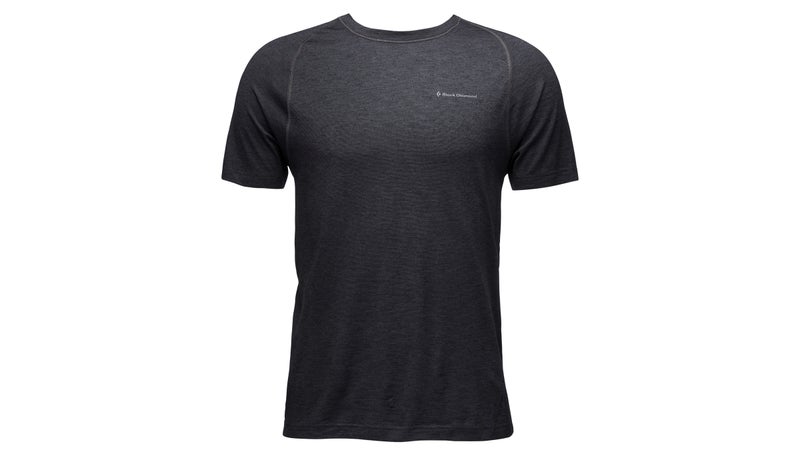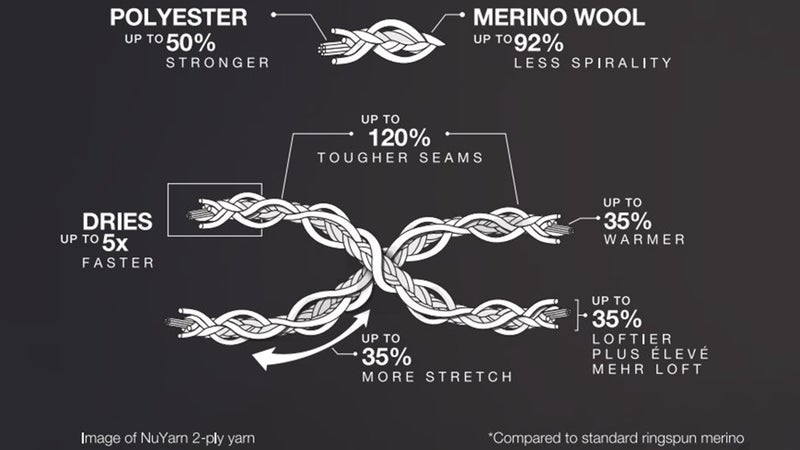At the end of a Black Diamond media lunch at Outdoor Retailer in��November, I was given a new gray T-shirt.��I’m notoriously particular about my athletic clothing, and I expected I’d��drop off this����at my local Goodwill before Christmas. Each year I receive mountains of new clothing, but I own only about a dozen go-to tops and bottoms—like an airy Smartwool long-sleeve from 2008, a wispy Salomon wind shirt from 2013, and a pair of versatile Road Runner Sports short tights from 2014—that fit and perform exactly how I want.
To my surprise,��the Rhythm tee worked its way into my system. I’ve run in it over 50 times, including multiple long outings��in the two-to-two-and-a-half-hour range,��and this spring I’ve been wearing it on training hikes with a 50-pound��pack in the foothills in advance of a busy summer-guiding schedule.
The Rhythm tee is a simple��pocketless crew-neck short-sleeved shirt. At $75, it shares the uppermost price bracket with T-shirts from Arc’teryx, Salomon S/Lab, and Smartwool.
Optimal Uses
I’ve found the Rhythm tee��ideal for road and trail runs in cooler temperatures (the upper forties��through the sixties, at which point I switch to a singlet or go shirtless)��and for hikes and backpacking trips in summertime conditions with low sun exposure (or with regular applications of sunscreen). It��could certainly be used for��other��outdoor activities, like climbing and cycling, but I haven’t used it for other sports.

Key Specs
- Pocketless, short-sleeved crew neck
- Size medium weighs exactly 100 grams
- 57��percent��nylon and 43 percent merino
- Available in�� and versions
- $75
Fabric
The Rhythm tee is most unique for its NuYarn fabric, a product of the Merino Company. NuYarn, made by wrapping merino fibers around a nylon core, is��57 percent nylon and 43 percent merino. I’d describe it as soft, airy, slightly textured, and lofty for its weight. After testing merino fibers between 17 and 19.1 microns, Black Diamond��says it settled on 18.5 microns for the Rhythm tee, because this fiber weight seemed to have the best balance of comfort and durability.
This tee��is made of 95 grams per square meter��of��NuYarn, which is about one-third lighter than standard lightweight��merino fabrics, which are usually 150 grams per square meter. It’s actually not much heavier than a pure synthetic—my size medium weighs exactly 3.5 ounces, versus 3.1 ounces��for my favorite polyester running T-shirt (made from��Columbia’s Omni-Freeze Zero).
I’ve long thought that synthetic-merino blends could offer the best of both worlds, and NuYarn seems to validate this. The Rhythm tee rivals the weight, moisture management, and durability of a pure synthetic knit top, like , but it also has the odor resistance and temperature regulation of a pure merino shirt, like the discontinued , making it suitable for long trips and wetter climates. I’ve yet to find any downsides.

Fit
The Rhythm tee has an athletic silhouette that, thankfully, fits me perfectly. I appreciate the extra inch or so��in torso length, too, especially while wearing a pack.��For context, with most tops I prefer a slim fit in a size medium; I can fit a relaxed size small, but the sleeves and length are usually too short.
If you have a more muscular or thicker build, do not be deterred. NuYarn is absurdly stretchy—about one-third stretchier than normal merino, per data from the supplier—so it’s more forgiving of different body types than more static fabrics.
Durability
My initial concern about the Rhythm tee was its stretch. With extensive use, I feared its fit would be lost, as happens with elasticized fabrics. But it fits me the same now as when it was new, because the stretch is inherent to the fabric knit. I should note that I rarely wash it as recommended—after a run or a hike, I usually bring my clothing into the shower, where I hand-wash it in a bucket with water and��mild��detergent.
The sole durability issue I have found is abrasion-related pilling of the NuYarn. So far it’s superficial. In my case, the pilling is most notable on the chest and shoulders��underneath my pack straps.
In-house Martindale abrasion testing suggests that the 95 grams per square meter��of��NuYarn fabric is more durable than the standard 150 grams per square meter of��wool, which has endured many normal thru-hikes. I’m not yet sure that I’d recommend it for extensive bushwhacking, though. Feedback from harder-wearing readers would be insightful.

Future Products
Black Diamond will expand its��use of NuYarn in the growing SolutionWool collection. This fall, expect a��base layer, long-sleeved crew shirt, tights, and three-quarter-length tights (as well as some midlayers and an insulated parka). And for��fall 2020, Black Diamond is considering a long-sleeved crew and long-sleeved hoodie.
These final products have me more interested. A NuYarn��long-sleeve would be ideal for running in cooler weather. And a NuYarn long-sleeved hoodie would be perfect for backpacking in the sun-blessed Mountain West. I’d give Black Diamond bonus points if it treats the fabric with permethrin so that I can wear it in the High Sierra during peak mosquito season.


